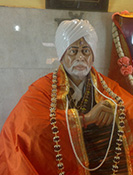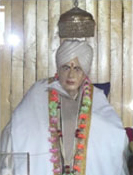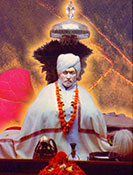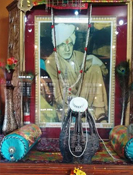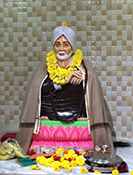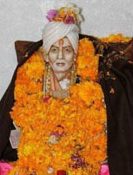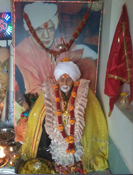“Jagat Guru Bhagavaan Gopinath Ji Charitable, Cultural and Research Foundation” Sidh Peeth Ashram (Regd.), Uttam Nagar, New Delhi has a mission to serve.
“Jagat Guru Bhagavaan Gopinath Ji Charitable, Cultural and Research Foundation” (Regd.) works for the cause of the Kashmiri Pandit community & culture in particular and for the humanity in general. It conducts research in to the teachings of Bhagavaan Ji for preserving them for posterity. We promote charitable activities, helping needy sections including the handicapped & destitute; provide medical treatment to many needy persons.
The present accommodation being least, the additional space requires the donation for expansion of Sidh-Peeth at Uttam Nagar, New Delhi & also to help and support the needy.
We request all to donate generously for the cause by sending crossed cheques / demand drafts in the name of “Jagat Guru Bhagavaan Gopinath Ji Charitable, Cultural and Research Foundation” (Regd.) against a proper receipt of the foundation.
You can directly send your contributions or donations to the bank account of the Foundation:-
- Account Name: - “Jagat Guru Bhagavaan Gopinath Ji Charitable, Cultural and Research Foundation” (Regd.)
- Bank Account No.:- 21250100028214
- NEFT / RTGS IFSC Code:- BARBOTRDNAW
- Bank Name: - Bank of Baroda
- Bank Branch: - Nawada, Uttam Nagar, New Delhi
But in case of transfer through bank kindly send the bank pay in slip receipt along with your particulars through post to obtain proper receipt for your use and also for the purpose of our accounts and records.
All the donations to the foundation is exempted from income tax under section 80G of income tax act 1961 vide D.I.T.(E) 80G/2010-11, J-504/818 dtd. July 7, 2010.
Pran Nath Koul ( President )
9868514295, 07838396400
Website: -
www.bhagavaangopinathji.org, (new)
www.bhagavaangopinathji.com (old)
Follow us at: -
www.facebook.com/bhagavaangopinathji
Please email your suggestions & comments to us at jagatguru1999@yahoo.co.in, jagatgurudevout@gmail.com
“By the Guru’s grace, disciples derive power from Brahma-Vishnu-Mahesh and the Gods; undoubtedly they attain liberation by serving Him –Shree Guru Geeta”.
Shree Guru is liberal at the Guru Mahotsava, which falls on the third day of July every year. This was the very day in 1999, when the media reported that Bhagavaan Gopinathji appeared at the Kargil hills during the battle with Pakistani intruders and was “noticed guiding our troops”. I
It was the third day of July in 1898 that Swami Vivekananda ji is reported to have visited Bhagavaan ji’s house at Bana Mohalla, Srinagar. A century later, the very same day saw an Rs 3 commemorative stamp on Bhagavaan Gopinathji being issued by the Department of Posts. It was also the third of July in 2000 when the inaugural issue of Prakash Bhagavaan Gopinath was published by our foundation.
The one enduring date through this – and perhaps other unknown, unwritten - narratives is the third of July. Clearly, this is a date of spiritual significance for Bhagavaan ji’s devotees.
This then brings us to what we can aspire to do this third of July. How can this day be commemorated? What can we do to further the message of Bhagavaan Gopinath ji and inculcate it in the younger generation?
And while we debate this, let us turn our thoughts to the significance of the Kashmiri Pandit calendar. All of us have since our childhood been made familiar with the “Nechipatra” or the Kashmiri almanac, that manifests in our daily life in the form a nice, little book that guides us through the year.
Our new year – Navreh – is the occasion when we get to see it afresh. This book is in part a compendium of prayers, mantras and other related things, but the most crucial part has to do with the calendar. And this is where the mystery lies for several of us – who have not yet become familiar with the correct manner of reading and interpreting what is written in it and its ritual significance.
While several youngsters of our community would be familiar with the almanac, perhaps there is need to ensure that many more become adept at reading and understanding it. How can that be achieved? Does it require a better explanation or perhaps a tutorial of sorts that allows the uninitiated to gather enough ability to read it? Can the community elders ensure that more formal training is imparted in the techniques that are essential to doing this?
In my view, there is a pressing need for precise and clear writing on this crucial matter. I invite our readers to contribute articles in this regard. Please try and keep it simple. Suggest a step by step method of reading and interpreting this almanac - as that would allow for greater dissemination of this vidya in the younger generation.
“Serve the needy, without any consideration of caste, creed and colour – to the best of your capability and capacities”.
A good deed is one that helps people – the doer and the beneficiary. Everyday we witness good deeds being performed around us - by the ordinary as well as the ordained. The gestures can inspire and motivate us. Let me share with you a recent event. It was a pleasant March morning and I was standing on the corner of a road, waiting for a friend to pick me up. Since my friend was delayed, I looked around for a rickshaw. There was just one and the owner was getting a tyre fixed. As I waited, I noticed a beggar. He was staring at the food on display at the roadside tea shop. As I watched, the rickshaw puller asked for a cup of tea and two bread-buns. I was about to turn away and start looking for another rickshaw – that I saw him give the tea and buns to the beggar.
It was then that it struck me – here was a man of humble means sharing a part of his hard earned income with someone who was even less fortunate. Feeling mortified and a bit ashamed, I asked myself whether I had lost all humanity and sense of giving. I moved on, but I have not been able to shake off the memory of that incident.
So, what does this incident mean to me and what is it that I try to draw from it?
For starters, it taught me a simple lesson: giving does not require you to be rich. In other words, does one have to necessarily have a huge amount of surplus income to undertake charity? In itself, charity does not have to be necessarily defined as giving away your wealth. This then raises another question – that of the nature of charity that one undertakes. Is giving money to a beggar charity or is giving money to a temple charity?
As I try and grapple with these thoughts, I am reminded of the wealth of knowledge that is available with us on this matter. Every culture and its society have their own version of charity. Religion teaches us to give. In fact, some customs actually encourage charity. The devout believe in giving to God, some believe in giving to atheists who run social organisations, yet others sponsor deprived children.
In all this, what does the community that Bhagavaan Gopinath blessed by being born into in the mortal avatar, do for charity? Do the children of the Vitastaa have a defined concept of charity? Is there need for such a concept that is based on common thinking on a community wide basis? Indeed, can there be a code for charity for every Kashmiri Pandit? Can our rituals see a change in that? Who will undertake this effort and how will the thought be propagated?
In raising these questions, I am trying to start a debate on this issue at a time when increasingly the immediate problems of a displaced existence seem to be getting replaced by existential questions. As a displaced people find their feet in an environment that is intensively competitive and brutal, can our proud and valiant community set a new standard for itself – in compassion and giving?
This is the message that Bhagavaan Ji left us with; a message that is imperative for all of us to follow and adopt. The concept of service can be defined in various ways and can be undertaken in various methods. Desire and understanding are essential to providing service to those who are most in need.
The motivation of such service should only be completely altruistic and without the desire to gain something in return. The “Seva Bhav” as enshrined and passed on from generation to generation in our community has managed to withstand the test of times and even withstood the aftermath of the forced displacement of the community.
Bhagavaan Ji has pointed out that “public donations” are the trust of the public and have to be handled with utmost care and honesty. Any misuse of such trust funds is akin to playing with fire or handling a snake – the moment you make one small mistake, the result is disastrous. Another example that can be cited for this is the manner in which a snake’s venom is harvested to make medicine. The venom itself can take a life, but when handled with utmost care and due process, can instead save a life. Public funds are also a matter of life and death and have to be handled with equal if not more care.
Let us now focus on another aspect of how Bhagavaan Ji taught us to help and serve the needy and depressed.
Once a devotee, a man of meagre means, approached him seeking help in the marriage of his young daughter. The desperate man was at his wits end. In fact, he even went to the extent of threatening to end his life as he was unable to fulfil his obligation in this regard. Bhagavaan Ji advised him not to despair and instead retain courage and hope. What followed next illustrates the principle that we are talking about. Using subtle inducements, Bhagavaan Ji ensured that several people from society came forward to help the marriage.
There are other instances of Bhagavaan Ji helping out even Sadhu’s undertake their religious duties. Several mendicants from various parts of the country used to visit Bhagavaan Ji seeking some help to fulfil the Amarnath Yatra. This was in the late 50s and early 60s. Bhagavaan Ji used to give a dakshina of one rupee each to these holy men and send them off for the Yatra. And such was the power behind the dakshina – that this one rupee used to go a long way in ensuring that the pilgrimage was conducted properly.
The story of the Kharyar Ashram, the first such institution built after Bhagavaan Ji left his mortal frame, is also an eye opener. Several devotees in the vicinity had approached Bhagavaan Ji for a donation to start construction of a small facility for conducting sermons and other activities. Bhagavaan Ji accepted their request and gave a token donation from his side. Less than a year later, this blessing proved to be the seed of what later on developed into his first memorial Ashram, which has only since multiplied to many locations and hopefully more will be added in the future.
The lasting legacy of all of this can thus be summarised to say: Donate for a just cause, never say no to the needy. Do not feel that your donation is paltry or not enough – it is the sentiment and the motive that is more significant. The smallest amount or act of charity can prove to be a seed for an effort that eventually acquires a large dimension and helps society in many ways.
That is the message that he left us with and that should be what all of us must aspire to do on a daily basis.
Editor’s Note:- We look forward to your contributions and manuscripts. Please email us at jagatguru1999@yahoo.co.in Siddharth Zarabi






